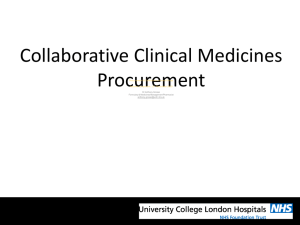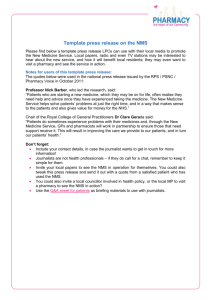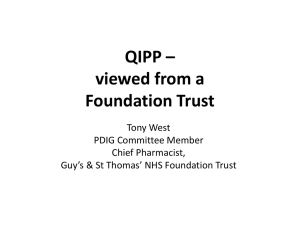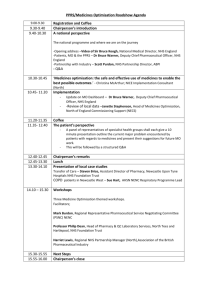PDIG Procurement Basics Course - Guild of Healthcare Pharmacists
advertisement
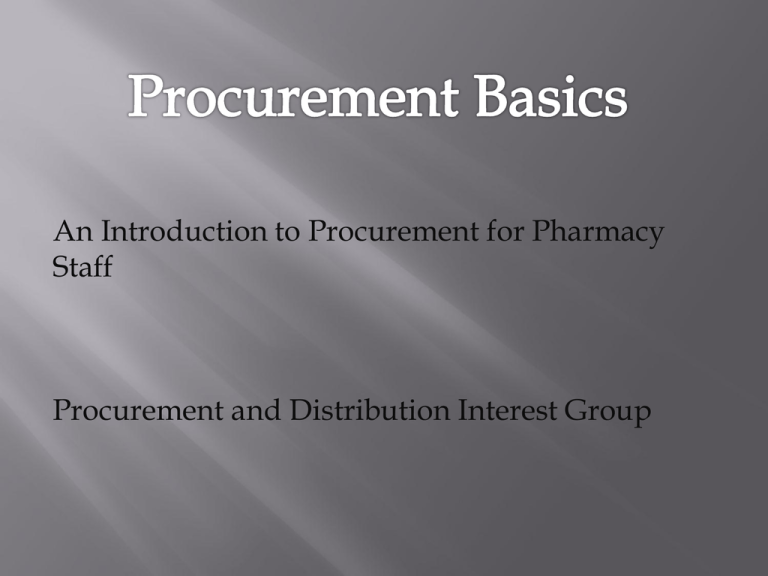
An Introduction to Procurement for Pharmacy Staff Procurement and Distribution Interest Group Why Should I Spend Time on this Programme? A word from David Webb... "Welcome to the procurement training programme. My name is David Webb and I'm Director of Specialist Pharmacy Services for South East England. Procurement is an essential, though often underrated, element of medicines optimisation. This training resource developed by Kevan Wind, Procurement Specialist for London and East of England (based at Southend Hospital NHS), and supported by the Guild of Healthcare Pharmacists Procurement and Distribution Group will help you develop a better understanding of the issues in procurement and the relevance of this activity to clinical practice. Getting 'the right drug in the right form at the right dose to the right patient at the right time' is predicated on timely access to cost-effective medicines." How This Works. The course is split into three modules to make it easier to complete. You can undertake them all at once or one at a time………………. In any order. Together the modules build to give you a basic understanding of the way medicines are procured in secondary and tertiary care in the NHS. Why we do it that way and how it fits in with the other parts of the pharmacy service elements and particularly medicines optimisation and management. We have tried to anticipate and answer the questions non procurement staff would ask about the way we do things so the course is structured as a series of questions that we hope we have then given the answers to. Thanks I hope you enjoy this activity and more importantly learn something. Kevan Wind Contents Module 1 • Why do all the packs of medicines in the dispensary change every so often? • A few of the packs we buy are labelled poorly. Why is this and why do we still buy them? • Why do we keep getting shortages? • What is Homecare and what is it used for? • What is a Parallel Import (PI) and why do we use them? • People talk about “supply chains” all the time. What is that and what is the difference between ordering from a wholesaler and other routes • How are medicines priced as they are? Contents Module 2 1. How can I help the pharmacy ordering office to obtain a new medicine? 2. Why should I talk to procurement when I don’t work there? 3. What training is available in pharmacy procurement 4. Industry can offer value added services. Are these ok to access and how should we deal with them ? 5. What is the best way to manage reps? 6. How do we go about sourcing a product out of hours when procurement staff are not here? Contents Module 3 1. How do we decide which suppliers to use? 2. Who is this CMU I keep hearing about? 3. Just what is OJEU? 4. Why should we worry about destabilising the market? Can’t we just award to the cheapest tender? 5. Can we sell pharmaceuticals to GP’s or the community, other hospitals or to abroad? 6. How does licensing work? Module 1 1. Why do all the packs of medicines in the dispensary change every so often? 2. A few of the packs we buy are labelled poorly. Why is this and why do we still buy them? 3. Why do we keep getting shortages? 4. What is Homecare and what is it used for? 5. What is a Parallel Import (PI) and why do we use them? 6. People talk about “supply chains” all the time. What is that and what is the difference between ordering from a wholesaler and other routes 7. How are medicines priced as they are? Question 1 Why do all the packs of medicines in the dispensary change every so often? To ensure the NHS achieves best value for money around procurement, and sources medicines from the most efficient suppliers, medicines in the NHS secondary care service are purchased collectively within contracts organised by The Commercial Medicines Unit (CMU). This section of the Department of Health (formerly PaSA or NHS Supplies) employs pharmacy buyers to manage our contracts for us. The buyers are not pharmacists but experts on procurement and help pharmacists manage the contracts. Contracts are binding on Trusts as well as suppliers. For this reason in the unusual event of a trust not being able to comply with a contract, the reasons should be given (ideally at the time of adjudication) to CMU for explanation to the supplier involved. Contract Areas in UK Division London East of England North West Division Contains All trusts within the M25 Essex, Bedfordshire, Herefordshire, Suffolk Peterborough and Norfolk. Lancashire, Liverpool, Cheshire, and Staffordshire North East Division Northumberland, Newcastle & Gateshead, Tyneside, Sunderland, Durham & Darlington, Teeside. Yorkshire Yorkshire. NB Yorkshire undertake their own tendering but cooperate with the rest of the NHS on procurement matters. West Midlands Birmingham, , Shropshire, West Bromwich, Coventry and Northants. Lincoln, Leicester, Derby and Nottingham East Midlands South Central South East South West The following are administered separately. Northern Ireland Scotland Wales Buckinghamshire, Berkshire, Oxfordshire and Hampshire Kent & Medway Surrey and Sussex Bristol, Dorset, Cornwall and Devon, Somerset, Wiltshire and Gloucestershire. Northern Ireland Scotland Wales CMU buyers and procurement pharmacists bring different types of expertise to the contracting process. Expertise of Pharmacists Clinical use of medicines Suitability of products for use Quality Assurance aspects of medicines Market (competition, introductions) Local issues around choice of medicines Local usage patterns Local Clinical Pharmacy Networks Expertise of CMU Buyers Legal aspects of procurement Administrative backup for contracting Alternative methods of purchasing Market (competition, introductions) Market price information (from national contract system PHATE) Typically contracts are tendered every two years. (Some are shorter when we expect rapid market changes (e.g. in a highly competitive market). However so long as both supplier and pharmacists are happy, a contract can be extended once (to make four years). This is the so called 2+2 model. Suppliers or the NHS retain the right to terminate the contract at the end of each 2-year period. Advantages of the Model •Preferential and transparent prices are made available to the NHS. •Products are assessed for quality (labelling and packaging) and competition is maintained in critical markets. •Administration input reduced for NHS Trusts, NHS CMU and the pharmaceutical industry. •Option for longer-term contracts with suppliers should facilitate stable prices and continuity of supply. •Less changes for dispensaries. •Suppliers and the NHS can place more emphasis on contractual performance which will be one of the criteria used for contract extension. The details of the contract are held centrally by CMU on their website (The CMU Pharmacy Catalogue). Access is password controlled and specific to the hospital of the user. Important Aspects to Consider As Contracts Change Before adjudicating the contract. Are there any local clinical issues that need resolution? Are all CIVAS, cytotoxic reconstitution, non sterile manufacturing and prepacking issues resolved with respect to offers? After the contract has been adjudicated. Do any price changes affect decisions around prepacks? Do any price changes affect decisions around formulary choices? Do any pack changes mean products have to be stored differently? Do any pack changes mean ward stock lists need adjusting? Do any pack changes mean ward staff need to be notified about using different diluents etc. Revision Questions 1. 2. 3. 4. What is the role of CMU in the procurement of medicines? What is The 2+2 model? What aspects should be considered once a new contract has been decided? What is the Pharmacy Catalogue and how can it be accessed? Additional resources CMU Website http://cmu.dh.gov.uk/ NHS standard terms and conditions of contract for the purchase of goods and supply of services http://www.dh.gov.uk/en/Publicationsandstatistics/Publications/PublicationsPolicyAndGuidance/DH_121260 Paper “Summary of Procurement Contracting Arrangements May 10” Kevan Wind - document linked on Procurement Training page of PDIG website Question 2 A few of the packs we buy are labelled poorly. Why is this and why do we still buy them? Answer The adjudication process is a compromise, the democratic decision of a number of trust representatives and what is ideal for one site may not match another. The following issues are considered to be important. Important Points Around Packaging and Labelling 1. All packs are assessed by the NHS QA team using a standard risk assessment tool. This categorises risk into high medium or low. High risk products are only awarded if there is no alternative and QA would then issue a “Safe Medication Bulletin” to highlight the specific issue and advise about mitigation techniques. 2. If you find a pack that has issues you should report it to your pharmacy office who can comment about alternatives and inform CMU about the problem. 3. Some requirements of the NHS (e.g. extended stability information for injections) are not available on the SPC but are stored on another CMU website called PharmaQC where they are known. 4. There is little primary research to indicate what type of packaging reduces picking errors. It is not clear whether all packs should look identical (to force users to read labels) or whether differentiation between packs (by means of colour or design) can help. Colour coding is NOT recommended. The National Patient Safety Agency (NPSA) have issued a Design for safety document on labelling. Additional Resources NPSA guidance on labelling http://www.npsa.nhs.uk/corporate/news/npsa-alerts-healthcare-workers-to-new-guidance-for-injecting-adults-andadolescent-patients-with-intravenous-cancer-drug/ MHRA guidelines on labelling of medicines http://www.mhra.gov.uk/home/groups/comms-ic/documents/publication/con007554.pdf Link to PharmaQC http://cmu.dh.gov.uk/medicines/pharmaqc-database/ Risk Assessment Tool (QA Group)document linked on Procurement Training page of PDIG website Safe Medication Bulletin example – document linked on Procurement Training page of PDIG website Revision Questions 1.What information is required by procurement staff in order to make correct decisions around products used in CIVAS or cytotoxic reconstitution units? 2.How are the labelling and packaging of medicines assessed by secondary care? Question 3 Why do we keep getting shortages? Answer The marketplace for medicines is very different to other types of market in that there are an unusually small number of customers with an unusually large number of suppliers. Pharmaceuticals are developed by manufacturers after years of research. These medicines are protected until patent expiry (and thus supplied from a single source). Subsequently their manufacture is augmented by generic competition. The “customer” for this market is almost exclusively the NHS. These facts make the procurement of medicines a unique challenge. It is a tribute to the competence of the manufacturers, distributors and the pharmaceutical purchasers that continuity of supply has in the most part been maintained. There are now external factors at work however that has resulted in an increasing level of supply failures. It is important that these factors are understood by all those in the supply chain so that appropriate action can be taken. Factors Involved in Recent Failures of the Pharmaceutical Supply Chain a)Increased Need for Profitability The costs of drug development are increasing as regulating authorities require more information on products before licensing. There is an increased requirement on pharmaceutical companies to deal in profitable pharmaceuticals. This means that companies either discontinue or divest themselves of products at an earlier stage than has been practice. These processes disrupt the supply chain. b)Reduction in Price of Generics The NHS has been effective in awarding contracts for generic medicines on the basis of price. The suppliers of these products have concentrated on price rather than supply performance. Moreover generic companies can only recoup sufficient profit if they contract for large volumes and hence strain their manufacturing capacity. c)Reduced Number of Suppliers in Markets The reducing returns on generic drugs has resulted in a rationalisation of the number of suppliers. There are now single suppliers for many critical products (Adrenaline, Glycopyronium, and Diamorphine). Obviously any disruption to these single suppliers leads to failures in supply. Factors Involved in Recent Failures of the Pharmaceutical Supply Chain d) Reduced Stock Holding The process of reducing costs by lowering stock holdings has been on-going in most logistic operations. However the user demand for pharmaceuticals is probably more variable than most, and the consequences of failure more severe. There is also a lack of investment in up to date technology, especially in the NHS. This means that extrapolating savings made in markets like foods and the car industry are not always appropriate. d) Increase in Manufacturing Standards Regulating authorities rightly demand increasingly stringent standards in the manufacture of medicines. Raised manufacturing costs lead to rationalisation of production facilities. Some products are made in a single site globally. This increases fragility of supply. For example a recent Caribbean hurricane lead to a temporary global shortage of a branded antibiotic as the worlds supply was manufactured there. Some manufacturers are struggling to meet standards leading to supply failures (e.g. vaccine supply to UK). Factors Involved in Recent Failures of the Pharmaceutical Supply Chain g. Lack of Good Usage Information Whilst primary care has accurate national (PACT) data on use. For hospitals (secondary care) the CMU provide usage information achieved through the PharmEx database which uploads purchase information from trusts. However gaps exist because not all homecare orders are made through the pharmacy systems and if a service is outsourced to a commercial provider usage information may not be collected. Potential Solutions A)Prevention More coordination of procurement decisions. The Pharmacy Market Support Group (PMSG) is tasked with making strategic awards on NHS medicines contracts to try and maintain competition in the specialist hospital market which is particularly prone to market consolidation and hence a higher risk of shortages. The PMSG membership reflects, or has access to, an appropriate range of expertise drawn from the NHS. The PMSG liaises with representatives from contracting groups engaged in tendering processes. The PMSG has developed a work plan which focuses on developing strategies for critical product areas where there are concerns about matters such as continued availability and competition in the market. The terms of reference of the PMSG are: •anticipate critical generic product shortages and to propose and co-ordinate preventative measures •prevent potential market monopolies being developed •encourage new entrants into critical markets •assist in managing branded products that have just come off patent •monitor the effectiveness and advantages of contracting in the UK hospital sector through benchmarking, audit and quality assurance ensure items are market tested regularly •inform new and existing suppliers about the contracting process •develop strategies to discourage unsuccessful suppliers from undermining contracts • co-ordinate contracting with Wales, N.I. and Scotland. B) Fire Fighting Once a significant shortage has developed, CMU, the Department of Health and senior procurement staff (called the Rapid Alert Group) cooperate to develop strategies to overcome the difficulties. These could involve the provision of advice to trusts on recommended plans of action. These may involve:•Obtaining alternative products from overseas markets. This may be unlicensed or need relabelling before use. •Liaison with alternative manufacturers (either commercial or NHS sterile manufacture) to boost production. •Local strategies within trusts to • preserve stock. •Therapeutic alternatives. These documents are normally produced by MI staff and posted on NELM. A useful resource is produced by UCLH. This website (Solutions) gives details of current shortages and suggestions of alternative sources of product. See www.uclhsolutions.com Additional Resources CMU Website Strategic Groups http://cmu.dh.gov.uk/medicines/strategic-groups Solutions website http://www.uclhsolutions.com/ PDIG talk by Andy Alldred on NPSG & PMSG. “How do we add value?” http://www.ghp.org.uk/groups/UAS@GK/JTHYST/PSYSJN Questions 1.Name three causes of shortages 2.What is the PMSG and why is it important in managing shortages? 3.What is Solutions and how could it be useful? Question 4. What is Homecare and What is it used for? Answer Homecare is a way of delivering specialised service and medicines direct into a patients home. Drivers for Homecare Services •Provision of extra services to patients in their home that may deliver real quality of life improvements. •Reduction of workload to secondary care trusts pharmacy departments. •Ability of tertiary referral centres to treat patients back in the community who are geographically distant from the centre. •VAT is not payable on services whereas it is on goods into secondary care. Thus these services can be funded out of tax revenue. •It may be less problematic to obtain services from homecare companies than to provide them in house. NB Many of these drivers are also addressed by the outsourcing outpatients model. This is outside the scope of this module but PDIG is currently doing some work on this. A rapidly growing market in England with £1 billion worth of medicines being distributed in this way Established companies with new market entrants The NHS needs to be a more co-ordinated customer to maximise potential of homecare Chief Pharmacist responsible for all medicines homecare in a trust. NHS needs to improve both clinical and financial governance of homecare Additional resources CMU Homecare Group Website http://cmu.dh.gov.uk/homecare-medicines-review-group/ Hackett Report http://cmu.dh.gov.uk/homecare-medicines-review-group/ Question 4 What is a Parallel Import (PI) and why do we use them? Answer The answer is that because of the relative strength of the pound vs. the euro in 2012 we don’t but this could change in the future. A parallel import is a product that has been imported into the UK from another part of the EU under the free movement of goods act. Before they can be imported however they have to be licensed in the UK as a parallel import. (see licensing later). So the chain of events that ensues is as follows:1.Manufactured (often in the UK). 2.Exported by manufacturer to intended market. 3.Supplied to wholesaler in intended market. 4.Sold to parallel importer by wholesaler in intended market. 5.Re-imported back into the UK. 6.Repackaged or relabelled with UK label and PIL according to licence. 7.Sold to UK market. Parallel Imports In primary care where community pharmacists are paid according to the Drug Tariff prices, profits from PI’s go to that pharmacy business. As a result of this the Prescription Pricing Authority (PPA) imposes a 10% clawback on prices for branded medicines to account for this. Any cost savings made in secondary care however go back to the NHS. It is important that Pharmacy Services recognise the potential benefits of parallel imports but also the risks. Good governance need to be in place to ensure that any activity is measured and responsible and maintains patient acceptability & safety, availability of medicines, as well as offering cost effective procurement of medicines. Advantages & Disadvantages of Parallel Importing Price •PI price may be significantly lower than UK price. •UK price may rapidly fall to match PI price. This may leave an existing arrangement, which must be honored in which goods are more expensive than new UK price. •Price may be subject to an adjustment for exchange rate changes. •It may be difficult to identify the profit margins being taken by traders. Product •Product may be less acceptable to clinicians or patients. Existing suppliers may exploit this factor. •Product may be labeled confusingly (e.g. different languages on blister). •Product could have different appearance to UK. •Product may be counterfeit. •Product may have been stored inappropriately at some point in its history. Advantages & Disadvantages of Parallel Importing Supply •Supplies may be limited or only available intermittently. •As a result of the extended supply chain arrangements (and often action by the manufacturers to limit supply) there are more supply problems with PI’s than conventional products. •Supply chain is complicated, and delivery times may be long and unpredictable. Purchase Arrangement •Parallel importing may compromise existing purchasing arrangements. •It may be difficult to satisfy auditors that these types of entrepreneurial arrangements are arranged with probity. •Arrangement may involve significant capital outlay (if product has to be bought in bulk). •Payments to traders will need to be made more quickly than usual (normally within 7 days). •Relationships with manufacturers may be damaged. Licensing •May take considerable time to obtain licences for specialist hospital products. Purchasing Arrangements To overcome the potential difficulties, & maximise the benefits, purchasing of PI’s is normally undertaken in the following way: 1.Parallel Imports will be purchased on regional contracts administered by NHS CMU. This ensures they are advertised & tendered in a formal manner. 2.All contract items & supplier companies are investigated by Quality Assurance. Checks are made on supplier premises & facilities as well as individual products. Special checks are made on labeling. 3.Only those products with a current British or European Licence (standard or for parallel importation) will be considered. An active response from the EMEA will be required before a European licensed product is considered acceptable to e imported. Additional Resources Link to European Association of Euro-Pharmaceutical Companies. www.eaepc.org ABPI website explanation of parallel imports http://www.abpi.org.uk/media-centre/newsreleases/2004/Pages/140604b.aspx Questions 1.List the steps that are involved in a parallel import being available to the UK market. 2.Name four advantages of parallel importing to the NHS 3.Name four disadvantages of parallel importing to the NHS. Question 6 What is the difference between ordering from a wholesaler and other routes The pharmaceutical supply chain is complex. The Pharmaceutical Supply Chain. Pharmaceutical wholesalers are fairly unique in that they provide a twice daily delivery to primary and secondary care pharmacies and stock most products required by their customers (full line wholesalers). They are paid by the manufacturers for doing this by being given 15% of the cost of the goods. Thus for a community pharmacist 85% of the price goes to the manufacturer and 15% to the wholesaler. Often part of this discount is given back to secondary care (often as much as 11%) as an incentive to use that particular wholesaler. Wholesalers also distribute contract products (at contract prices) on behalf of some manufacturers to secondary care. These products do not qualify for discount. Agency Schemes Some manufacturers do not allow wholesalers to distribute their products. These have to be purchased direct from the manufacturer. The supply position has become more complex lately with direct to pharmacy schemes. Using these manufacturers use wholesalers as a distributor rather than selling the product to them direct. This allows the manufacturers to pass on a lower distribution fee to wholesalers. GSK, Pfizer and many other companies operate these “agency” schemes through a restricted number of wholesalers. Features of Direct vs Wholesaler Distribution Additional Resources BAPW http://www.bapw.net/ AAH http://www.aah.co.uk/ Alliance http://www.alliance-healthcare.co.uk/ Phoenix http://www.myp-i-n.co.uk/ Mawdsleys http://www.mawdsleys.co.uk/ CMU Wholesaler contract specification. Questions 1.Name three members of the pharmaceutical supply chain. 2.What is an agency scheme? 3.Give two advantages to a trust of a wholesale distribution model. Question 6 How are medicines priced as they are? Answer There are a number of factors that impact on the pricing of pharmaceuticals in the UK. 1. Pharmaceutical Price regulation Scheme (PPRS) The PPRS covers all branded licensed medicines marketed in the UK so long as the manufacturer is affiliated to the ABPI and has a turnover over a certain threshold. PPRS is a voluntary agreement between the branded pharma industry and government regulating the market price of pharmaceuticals. Under this scheme, company profits are pegged to investment in capital and research, and thus prices are controlled, although companies have the right to modulate prices within their portfolio. The PPRS also limits the number of changes to pricing policy that are allowed, and hence provides market price stability (at least of community list price). This is the principle method of cost containment of prices for the UK government, although other would argue it “allows” pharma guaranteed profits. The PPRS did not cover generic medicines. Currently the DoH has a separate scheme that caps the price of many generics. This generic pricing scheme is “negotiated” with the generic manufacturers 2. Reference Pricing Governments around the world regulate the price of pharmaceuticals by a variety of means. One involves referencing the price to the UK price. As a result of this manufacturers prefer to have a high UK price, even if this affects their sales in the UK. This could then mean though that the drug is not cost effective, particularly if it undergoes a NICE appraisal. As a result of these two conflicting imperatives there has been an invention of elaborate pricing mechanisms in the UK. a) Patient Access Schemes “Hide” the real price of the medicine by giving users a rebate or capping the doses that are paid for according to the details of the scheme (clinical effect, length of treatment etc.) b) Retrospective Discounts A payment is made back to the user based on volume used or some other measure. NB NICE and PPRS allow patient access schemes but not all patient access schemes go through NICE. Different types of discount Type of Discount On Line Discount Retrospective Discount Advantages Available immediately Able to pass on to directorates easily Simple and easy to deal with Prices look good. Free Stock Settlement or Prompt Payment Discount Disadvantages Difficult to identify separately Difficult to keep for pharmacy May not have earned it, leading to retrospective penalties May be less value than retrospective discount Not always offered. Savings not as obvious Easy to separate money into a separate account Easy to identify how much saved Only receive discount once earned Cheaper to supplier than on line discount Not easily traced Have to wait for money Difficult to pass on to users in a fair way May vary depending on performance Complicated to keep track of. Gives access to lower prices than would otherwise be possible (PPRS) Popular to companies Allows larger discount than would otherwise be the case Payment relatively simple (although still have to reconcile the payments vs. deliveries). Costly and difficult to price goods correctly on pharmacy computer system Can be difficult to allocate discount fairly to users. Have to pay money in advance (thus creates cash flow problems) May end up paying more than necessary if ordering activity low. 4. Competition Act The Competition Act has been introduced by the EEC to limit unfair practices such as loss leading and predatory pricing. After a pharmaceutical manufacturer (Napp) was prosecuted, this has had the effect of limiting the range of prices available within the market. Additional Resources PPRS Explanation on DoH website www.doh.gov.uk/pprsjuly.htm PPRS explanation on ABPI website http://www.abpi.org.uk/ourwork/commercial/pprs/Pages/default.aspx Explanation of the Competition Act – document linked on Procurement Training page of PDIG website Questions 1.Explain the PPRS and how it affect prices in the UK 2.Why might a company accept low sales in the UK as a result of a high market price? 3.Explain the difference between on line and retrospective discount. Kevan Wind 14.2.12.
